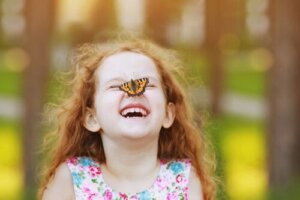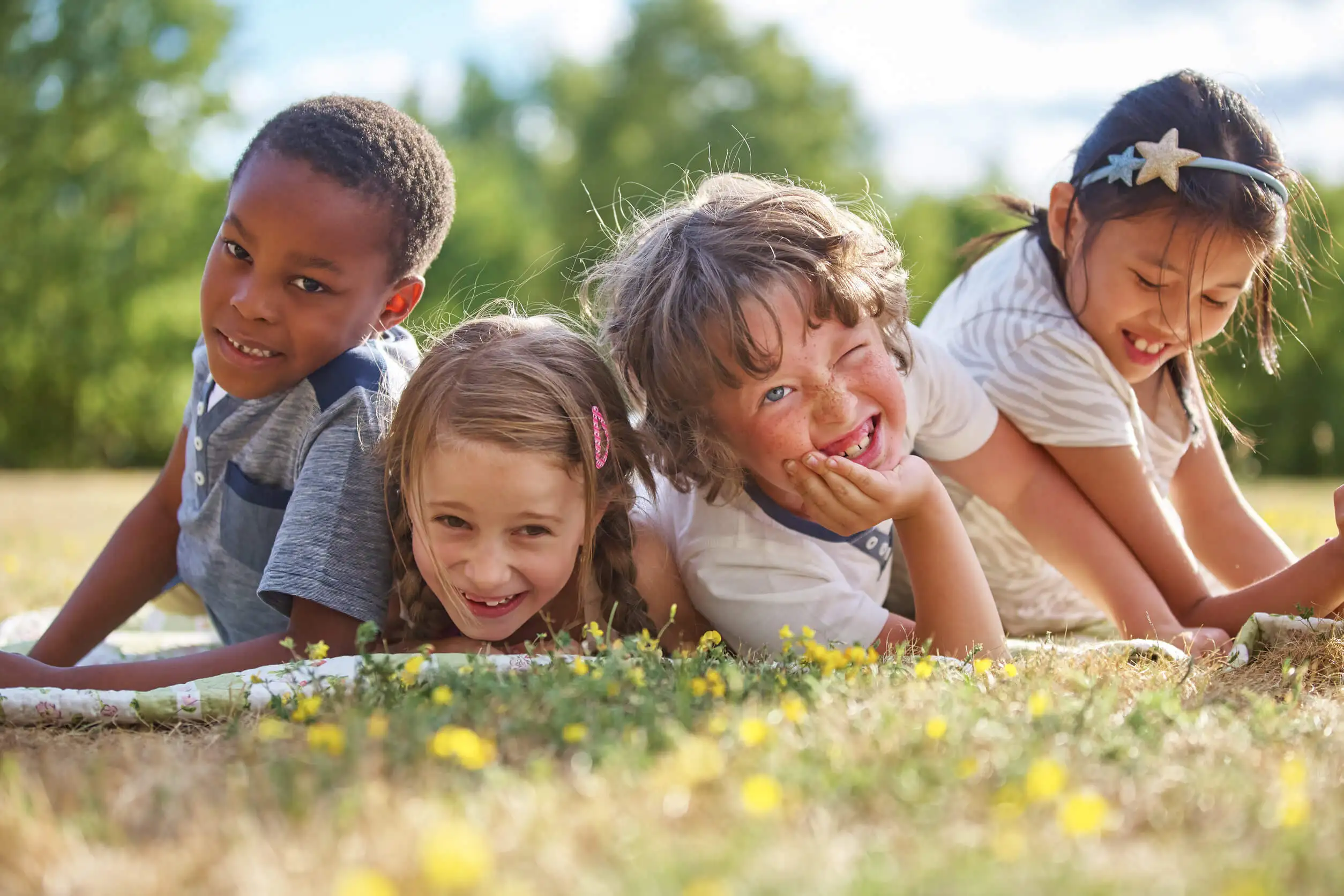Nature Deficit Disorder: How Does it Affect Children?


Written and verified by the doctor María Irene Benavides Guillém
Nature deficit disorder refers to the effect of disconnection from nature on childhood development.
This is not yet classified as a disease. Therefore, it’s not a medical diagnosis. However, there is growing concern about its potential implications for children’s health. In fact, it’s one of the causes of increasing childhood depression, anxiety, and obesity.
Why are children ailed by nature deficit disorder?
Children are spending less and less time outdoors. Meanwhile, they’re staying indoors more, playing more video games, and interacting more with electronic devices. Most likely, this phenomenon is due, in part, to the urbanization and digitalization of modern times.
Tandon et al. conducted a study in which they investigated the reasons why parents restricted their children’s activities outside the home. Thus, the reasons were diverse. There are concerns about safety, increased traffic, and even the weather. Playing outside unsupervised is not an option, but lack of time and energy due to employment does not give caregivers a chance to “go out and play” with their children.
On the other hand, many children are left in the care of grandparents while their parents work. In such a case, it may be difficult for older adults to accompany them in this type of play.
It’s possible that nature deficit disorder is a reflection of other social problems. For instance, one is a sense of insecurity and fear. The second is excessive planning of children’s activities.
Screen time, green time, blue time
Most importantly, to better understand what happens in nature deficit disorder, it’s necessary to familiarize ourselves with a few concepts. The first of these is screen time. This is the time spent by children with electronic devices such as a cell phone, television, tablet, computer, or video game consoles.
In 1970, children began watching television regularly at age 4. Today, they begin interacting with digital media at 4 months. More than 90% of children under 1 year of age have used a mobile device. -American Academy of Pediatrics (AAP)
Green time is the time children spend outdoors in a place where there is vegetation. Oswald et al. published a review of 186 articles in the journal PLoS ONE. They concluded that too much screen time negatively affects the mental health of children and adolescents. Meanwhile, green-time is associated with a positive outcome.
Blue time is the time we spend in environments with bodies of water, such as seas, lakes, or rivers. However, this has been less studied.
The combination of too much screen time and too little green time gives rise to nature deficit disorder.
You may also like to read this article: 5 Benefits of Eco-Friendly Terraces and Roofs
The benefits of contact with nature for children
Research on the relationship between nature and children’s well-being is increasing. Fyfe-Johnson et al. published in the journal Pediatrics a review of 296 articles on the impact of nature on children’s health. They found that contact with nature is associated with more physical activity and better mental health.
Among the positive effects attributed to nature are the following:
- It improves their academic performance.
- Nature stimulates the senses, imagination, and creativity.
- It helps children’s motor, sensory, psychological, and intellectual development.
- It strengthens their self-confidence and the ability to solve problems on their own.
- Nature increases their attention span and concentration. Reduces mental fatigue.
- It improves sleep due to its effect on the circadian rhythm and the sleep-wake cycle.
- It increases their happiness and sense of well-being.
- Natuer improves their quality of life.
Children who have more contact with nature have better social skills. Playing outdoors helps them develop their cooperative language, makes them more conversational, and improves their communicative competence.
Connecting with nature increases their curiosity and enthusiasm for learning. It makes them question their surroundings, relieves their stress and anxiety, and encourages them to be less aggressive and more in control of their emotions.

Preventing nature deficit disorder keeps illnesses at bay
Likewise, the aforementioned review found innumerable benefits in preventing the onset of diseases:
- It decreases the risk of suffering from cardiovascular diseases.
- It prevents asthma. This is possible because they are breathing cleaner air.
- It contributes to the diversity of the microbiome and strengthens the immune system.
- It prevents myopia, thus improving visual acuity. The exact reason is unknown, but it’s thought to be due to exposure to natural light.
The younger the age, the better
The earlier children come into contact with nature, the greater the benefits. That’s why it’s essential that it’s from the first years of life.
Stimuli at this age can influence cognition. Brain plasticity is greater at an early age. So is the capacity to respond to the environment.
Thus, in Belgium, the ENVIRONAGE study showed that the presence of more green areas around homes improves motor performance and visual memory in children aged 4 to 6 years. This is independent of prenatal and postnatal exposure to environmental pollution.
The consequences of nature deficit disorder in children
Nature deficit has considerable repercussions on the physical and mental health of children. Those who do not engage in outdoor activities tend to be more sedentary. This makes them more often overweight and obese.
In turn, they may be deficient in vitamin D due to lack of sun exposure. At the same time, they are more introverted and have low self-esteem. They are more prone to stress, anxiety, and depression.
Children become disconnected from their environment. They show little interest in nature and a great lack of knowledge about it. Hence, it is more difficult for them to be environmentally and ecologically conscious.
A call to prescribe nature to children: The “green prescription”
Health organizations are not oblivious to what is happening. Various organizations around the world have expressed their views on the matter. Doctors, especially pediatricians, are urged to give clear indications to parents and caregivers about contact with nature or to “prescribe nature.”
This is called the “green prescription.”
The Spanish Association of Pediatrics on nature exposure
The Spanish Association of Pediatrics (AEP) called for a Global Alliance to renaturalize childhood health. According to the organization, a city should have a green ratio of 3-30-300: you should be able to see at least 3 trees from your window, have at least 30% of green areas in your neighborhood, and these should be at least 300 meters from your home.
A child should spend at least one to two hours in a natural green or blue environment for healthy development. If he/she does not, he/she has a nature deficit. -Asociación Española de Pediatría (AEP
The American Academy of Pediatrics recommendations
The American Academy of Pediatrics (AAP) launched a campaign to empower parents about their children’s use of electronic devices. Children younger than 18 months should not use mobile devices for any purpose other than video calls. Those aged 18 months to 5 years should only do so in the company of their parents and for a maximum of 1 hour a day. Thereafter, including adults, no more than 2 hours a day is recommended.
In addition, they should not be used to calm the child. They should not be allowed to be used in sleeping rooms or at mealtimes.
They also recommend that children be physically active for at least 60 minutes a day. Likewise, there should be hours of play free of mobile devices.
The World Health Organization (WHO) recommendations
The World Health Organization (WHO) published its guidelines on physical activity, sedentary behavior, and sleep for children under 5 years of age in 2019. In children under 1 year of age, no screen use is recommended. In children under 5 years, no more than 1 hour. After the age of 2 years, at least 180 minutes of daily physical activity is recommended.
The Indian Academy of Pediatrics recommendations
In India, children are exposed to electronic devices from the age of 2 months with an average age of 10 months. For this reason, the Indian Academy of Pediatrics followed suit, publishing its guidelines for the use of electronic devices in children and adolescents in 2021. The versions for parents can be consulted by clicking here.
This organization discourages its use in children under 2 years of age. In turn, up to 5 years of age, it should be limited to 1 hour and a maximum of 2 hours up to 10 years of age. Sessions should not be longer than 30 minutes.
Children over 10 years old should have at least one hour daily of outdoor physical activity. In no case should screen time replace outdoor activities, sleep, interaction with other children, studies, or family time.

Nature as therapy for children with ADHD
Contact with nature is beneficial for children with attention deficit hyperactivity disorder (ADHD). For example, Taylor and Kuo report that with a 20-minute walk in the park, an improvement in their attention is already noticeable. In addition, parents report that children who play outdoors have milder symptoms.
Furthermore, many studies show that the more “green” they are, the lower the frequency of ADHD. In fact, researchers in Germany, China, and Denmark found that children who lived surrounded by greenery had about a 20% lower risk of ADHD. Similarly, the ENVIRONAGE study in Belgium had these results. And, the same is true in the Netherlands, where there are more green spaces.
The reasons for these findings are unknown. Some postulate that they are due to the relaxing capacity of nature. Certainly, it allows our attention to restore, and the child to recover from overstimulation and stress.
Family activities to prevent nature deficit disorder in children
To begin, contrary to what you might think, to connect with nature we don’t have to travel far from the city. Any place with plants, flowers, and animals, such as a garden or a park, allows us to do so. There is nature everywhere in these places.
Here are some ideas to share with your children and prevent nature deficit while having fun together:
- Go to the beach.
- Plant a garden.
- Plant a tree.
- Have a pet.
- Visit farms.
- Build a tree house.
- Observing and photographing animals.
- Take a biking or walking trail.
- Hanging a swing from a tree in the yard.
- Walking barefoot in the sand or grass.
- Lying in the grass and looking for shapes in the clouds.
Do you know: What is Digital Amnesia and How Can You Prevent It?
To learn more about how to regain a connection with nature, there are initiatives such as The National Environmental Education Foundation (NEEF) and Children & Nature Network. The important thing is to make combating the nature deficit a family goal and priority.
When it comes to playing outdoors, as parents and caretakers we should not forget to protect children from the sun. In this way, we will get the most out of nature without taking unnecessary risks.
In addition, it’s crucial to keep in mind that an example teaches more than words. Note that nature deficit is not just a children’s issue. Therefore, the AAP has made a plan for families available in Spanish; this is a tool to organize activities and avoid excessive screen time.
Meanwhile, we must stress the importance of parents teaching their children to love and protect nature. They won’t learn to respect it and take care of it otherwise.
All cited sources were thoroughly reviewed by our team to ensure their quality, reliability, currency, and validity. The bibliography of this article was considered reliable and of academic or scientific accuracy.
- COUNCIL ON COMMUNICATIONS AND MEDIA. Media and Young Minds. Pediatrics. 2016;138(5):e20162591.
- de Vries S, Verheij R. Residential green space associated with the use of attention deficit hyperactivity disorder medication among Dutch children. Front Psychol. 2022;13:948942.
- Directrices sobre la actividad física, el comportamiento sedentario y el sueño para menores de 5 años. Washington, D.C.: Organización Panamericana de la Salud; 2019. Licencia: http://iris.paho.org.
- Dockx Y, Bijnens EM, Luyten L, Peusens M, Provost E, Rasking L et al. Early life exposure to residential green space impacts cognitive functioning in children aged 4 to 6 years. Environ Int. 2022;161:107094.
- Driessnack M. Ask the expert. Children and nature-deficit disorder. J Spec Pediatr Nurs. 2009;14(1):73-5.
- Fyfe-Johnson AL, Hazlehurst MF, Perrins SP, Bratman GN, Thomas R, Garrett KA, Hafferty KR, Cullaz TM, Marcuse EK, Tandon PS. Nature and Children’s Health: A Systematic Review. Pediatrics. 2021;148(4):e2020049155.
- Gupta P, Shah D, Bedi N, Galagali P, Dalwai S, Agrawal S et al; IAP Guideline Committee On Digital Wellness And Screen Time In Infants, Children, And Adolescents. Indian Academy of Pediatrics Guidelines on Screen Time and Digital Wellness in Infants, Children and Adolescents. Indian Pediatr. 2022;59(3):235-244.
- Markevych I, Tesch F, Datzmann T, Romanos M, Schmitt J, Heinrich J. Outdoor air pollution, greenspace, and incidence of ADHD: A semi-individual study. Sci Total Environ. 2018;642:1362-1368.
- Ne’matullah K. F., Talib N. A., Mee R. W. M., Pek L. S., Amiruddin S, Ismail M. R. The impact of outdoor play on children’s well-being: A scoping review. Masyarakat, Kebudayaan Dan Politik, 2022;35(3):282–296.
- Ortega-García J.A., Martínez-Gómez C, Bach A, Benítez-Rodríguez L, Ramis R; Alianza Global para Renaturalizar la Salud de la Infancia y Adolescencia (GRSIA). Creciente desconexión de la naturaleza. Urge una alianza de salud global para la prescripción de naturaleza. Anales de Pediatría. 2023;98 (1):76-78.
- Oswald TK, Rumbold AR, Kedzior SGE, Moore VM. Psychological impacts of “screen time” and “green time” for children and adolescents: A systematic scoping review. PLoS One. 2020;15(9):e0237725.
- Rodríguez Piña I. Causas y consecuencias del síndrome de déficit de naturaleza (Nature déficit disorder) y su aplicación al aula [tesis]. Sevilla: Universidad Internacional de La Rioja; 2014.
- Sprague NL, Bancalari P, Karim W, Siddiq S. Growing up green: a systematic review of the influence of greenspace on youth development and health outcomes. J Expo Sci Environ Epidemiol. 2022;32(5):660-681.
- Tandon PS, Hafferty K, Kroshus E, Angulo A, Burton M, Peyton M et al. A Framework for Pediatric Health Care Providers to Promote Active Play in Nature for Children. J Prim Care Community Health. 2022;13:21501319221114842.
- Thygesen M, Engemann K, Holst GJ, Hansen B, Geels C, Brandt J, Pedersen CB, Dalsgaard S. The Association between Residential Green Space in Childhood and Development of Attention Deficit Hyperactivity Disorder: A Population-Based Cohort Study. Environ Health Perspect. 2020;128(12):127011.
- Tillmann S, Clark AF, Gilliland JA. Children and Nature: Linking Accessibility of Natural Environments and Children’s Health-Related Quality of Life. Int J Environ Res Public Health. 2018;15(6):1072.
- Yang BY, Zeng XW, Markevych I, Bloom MS, Heinrich J, Knibbs LD et al. Association Between Greenness Surrounding Schools and Kindergartens and Attention-Deficit/Hyperactivity Disorder in Children in China. JAMA Netw Open. 2019;2(12):e1917862.
- Ye T, Yu P, Wen B, Yang Z, Huang W, Guo Y et al. Greenspace and health outcomes in children and adolescents: A systematic review. Environ Pollut. 2022;314:120193
This text is provided for informational purposes only and does not replace consultation with a professional. If in doubt, consult your specialist.








